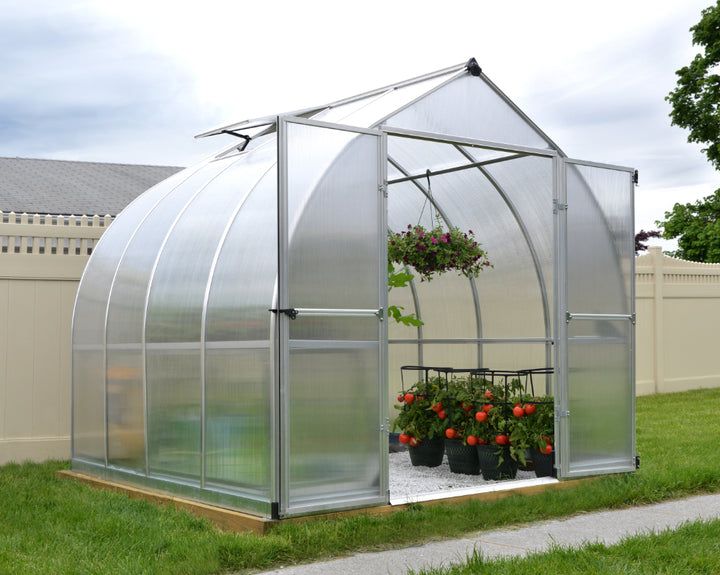
As a greenhouse grower, you should know the importance of maintaining and protecting our greenhouse. Proactive greenhouse maintenance prevents unwanted pests and diseases, reduces equipment breakdowns, optimizes operational efficiencies, and enhances crop productivity. A well-maintained greenhouse will be more efficient and productive and will last longer.
Different types of greenhouse sheets require different cleaning methods. For instance, the maintenance routine for polycarbonate sheets differs from how you care for a greenhouse made with acrylic or coroplast sheets. This article contains general maintenance tips for all greenhouse sheets and how to care for each type.
Types of Greenhouse Sheets
Greenhouse sheets are made with any of the following materials.
Polycarbonate Sheets
There are many benefits of polycarbonate sheets for greenhouses. They are lightweight and shatter-resistant, can withstand UV rays, and are stronger than glass. This material is perfect for greenhouses because it lets in a lot of light and has good insulating properties. One of the common myths about polycarbonate sheets is that it yellows over time but that is not true.
Acrylic Sheets
Acrylic sheets share some similarities with polycarbonate but are not as strong and resilient as polycarbonate and come at a lower price.
Coroplast Sheets
Coroplast has many benefits when used for a greenhouse. It can illuminate a space with tons of natural lighting and maintain internal temperature control, which plants in a greenhouse need. It is also lightweight and affordable and can withstand strong weather conditions.
General Maintenance Tips for All Greenhouse Sheets
No matter the type of sheet your greenhouse is made of you must inspect it regularly to identify any signs of damage, such as cracks, chips, holes, or diseases such as powdery mildew or root rots to prevent further damage.
Generally, it is recommended that you clean your greenhouse interior at least once a year. But we recommend cleaning in October and in April. This is because greenhouses do not get much attention in the winter, allowing pests and diseases to thrive.
To clean your sheets, you need mild soap and warm water, and disinfectant. Harsh chemicals and rough materials scratch or damage the surface of the sheets. So, use a soft cloth or sponge and a drying towel. A ladder is needed to ensure you reach every part of your greenhouse.
Controlling humidity in greenhouses is very important to the growth of mould and mildew. Ventilation is needed to control high temperatures during the summer to ensure uniform airflow throughout the greenhouse. Do not store in direct sunlight, use sloped stacking, and avoid placing or dragging heavy objects on the sheets.
Maintenance Tips for Polycarbonate Sheets
- Address scratches and minor damages. The best way to remove scratches from your polycarbonate sheet is by buffing them with a soft cloth and Novus or Plexus plastic polish.
- Manage condensation and algae growth. Condensation is caused by temperature differences inside and outside the greenhouse which can affect the growth of your plants. You can deal with this by properly ventilating the greenhouse with ventilation pans.
- Ensure proper UV protection. Polycarbonate sheets are UV-resistant, but they can be enhanced with UV-resistant coating to extend the lifespan of your polycarbonate sheets and clean regularly to get rid of debris or dirt that can impede the effectiveness of UV protection.
Maintenance Tips for Acrylic Sheets
- Deal with scratches and scuffs. If you notice scratches or scuffs on the sheet, you can remove them with sandpaper; rub it over the scratched area in a circular motion until the scratch is gone and apply an acrylic polish.
- Use proper cleaning techniques to avoid damage. Cleaning acrylic is quite easy. You typically need warm, soapy water and a sponge or a soft material. Any cleaning agent containing ammonia should be avoided.
- Maintain structural integrity. Silicone sealant is another material that can help you repair cracks and maintain your greenhouse sheet’s structural integrity.
Maintenance Tips for Coroplast Sheets
- Keep the sheets dry and clean. Water and mild soap are enough to clean your coroplast or corrugated sheet.
- Address warping and bending issues. Gently apply heat or pressure to reshape your coroplast sheet.
- Consider handling and storage. Like other greenhouse sheets, avoid hitting them with hard objects while tending the plants.
Get Professional Assistance from Canada Plastics and Belting Inc.
You can maintain your greenhouse sheets following the tips in this article; however, if there is severe damage or cracks to your sheets, you should hire a professional maintenance and repair service provider to handle them. Leaving it unaddressed can render the sheet less effective.
Partner with a reliable distributor like Canada Plastics and Belting Inc. if you want high-quality polycarbonate corrugated panels and continual support and advice on how to maintain your greenhouse. Contact us today or call us at (416) 291-3036 for a free quote.
Related Product:
